PUBH5034: Literature Review on Developing Screening Study Guidelines
VerifiedAdded on 2023/06/14
|10
|2385
|375
Literature Review
AI Summary
This literature review addresses the need for improved reporting guidelines in screening studies, highlighting the limitations of current guidelines like STROBE, CONSORT, PRISMA, MOOSE, and STARD. It emphasizes the importance of clear, comprehensive, and credible reporting to inform healthcare policy and clinical practice. The review uses a secondary research method, including a Google Scholar search, and qualitative research methods to analyze existing literature. It acknowledges limitations such as reliance on specific databases and time constraints while justifying the study's importance in providing healthcare professionals with better guidelines for accurate data interpretation and decision-making in screening programs. The goal is to enhance the quality of research and improve patient outcomes by developing reporting guidelines that facilitate transparent and effective communication of screening study results.
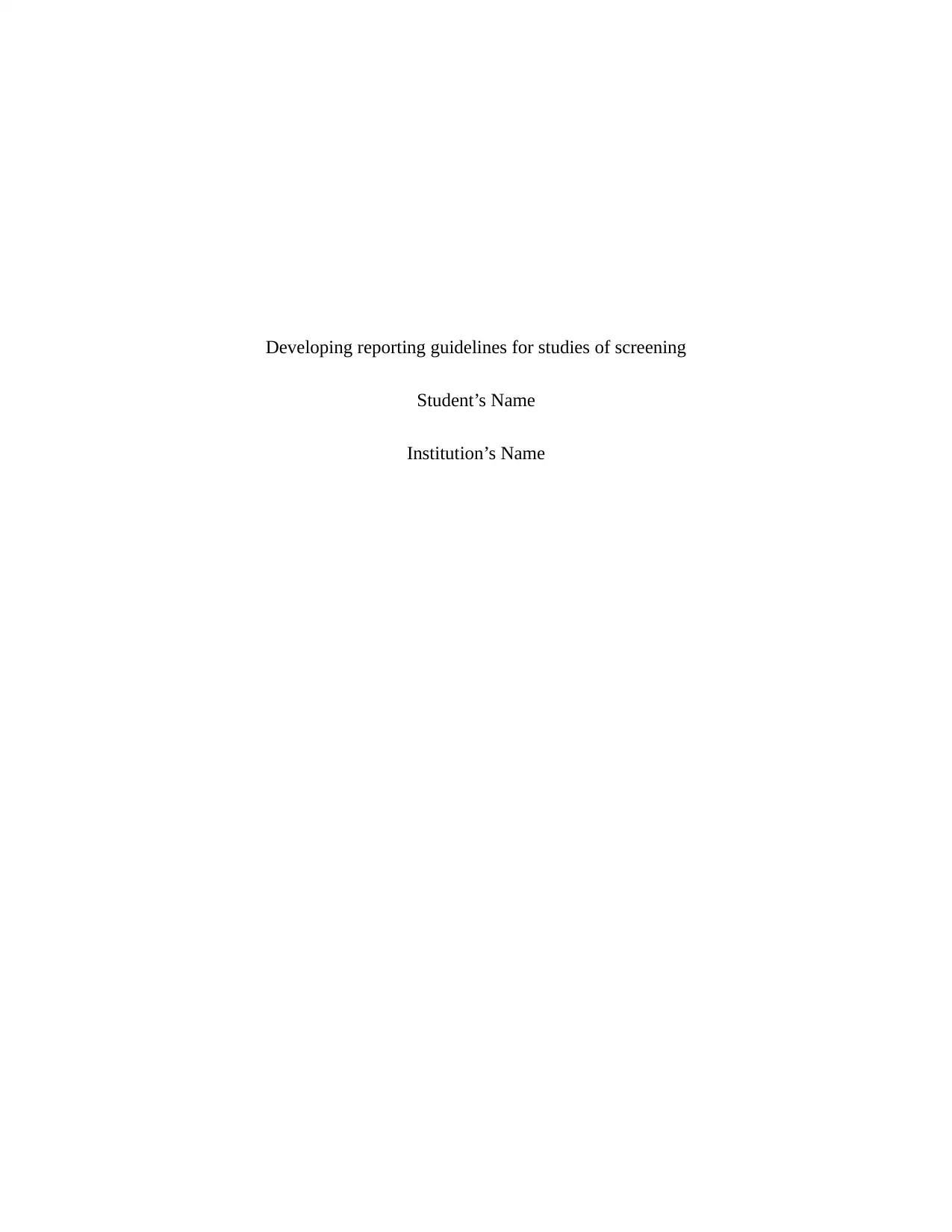
Developing reporting guidelines for studies of screening
Student’s Name
Institution’s Name
Student’s Name
Institution’s Name
Paraphrase This Document
Need a fresh take? Get an instant paraphrase of this document with our AI Paraphraser
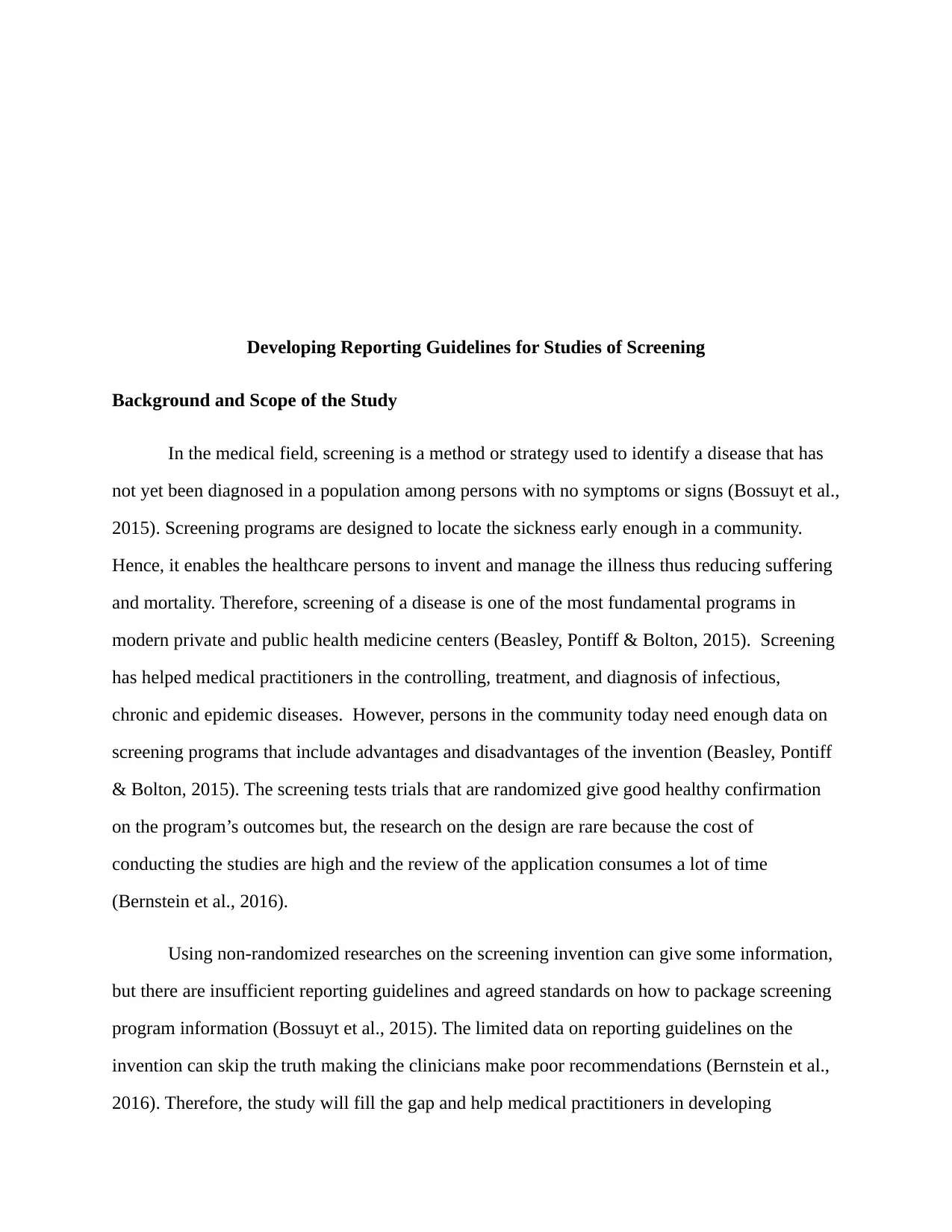
Developing Reporting Guidelines for Studies of Screening
Background and Scope of the Study
In the medical field, screening is a method or strategy used to identify a disease that has
not yet been diagnosed in a population among persons with no symptoms or signs (Bossuyt et al.,
2015). Screening programs are designed to locate the sickness early enough in a community.
Hence, it enables the healthcare persons to invent and manage the illness thus reducing suffering
and mortality. Therefore, screening of a disease is one of the most fundamental programs in
modern private and public health medicine centers (Beasley, Pontiff & Bolton, 2015). Screening
has helped medical practitioners in the controlling, treatment, and diagnosis of infectious,
chronic and epidemic diseases. However, persons in the community today need enough data on
screening programs that include advantages and disadvantages of the invention (Beasley, Pontiff
& Bolton, 2015). The screening tests trials that are randomized give good healthy confirmation
on the program’s outcomes but, the research on the design are rare because the cost of
conducting the studies are high and the review of the application consumes a lot of time
(Bernstein et al., 2016).
Using non-randomized researches on the screening invention can give some information,
but there are insufficient reporting guidelines and agreed standards on how to package screening
program information (Bossuyt et al., 2015). The limited data on reporting guidelines on the
invention can skip the truth making the clinicians make poor recommendations (Bernstein et al.,
2016). Therefore, the study will fill the gap and help medical practitioners in developing
Background and Scope of the Study
In the medical field, screening is a method or strategy used to identify a disease that has
not yet been diagnosed in a population among persons with no symptoms or signs (Bossuyt et al.,
2015). Screening programs are designed to locate the sickness early enough in a community.
Hence, it enables the healthcare persons to invent and manage the illness thus reducing suffering
and mortality. Therefore, screening of a disease is one of the most fundamental programs in
modern private and public health medicine centers (Beasley, Pontiff & Bolton, 2015). Screening
has helped medical practitioners in the controlling, treatment, and diagnosis of infectious,
chronic and epidemic diseases. However, persons in the community today need enough data on
screening programs that include advantages and disadvantages of the invention (Beasley, Pontiff
& Bolton, 2015). The screening tests trials that are randomized give good healthy confirmation
on the program’s outcomes but, the research on the design are rare because the cost of
conducting the studies are high and the review of the application consumes a lot of time
(Bernstein et al., 2016).
Using non-randomized researches on the screening invention can give some information,
but there are insufficient reporting guidelines and agreed standards on how to package screening
program information (Bossuyt et al., 2015). The limited data on reporting guidelines on the
invention can skip the truth making the clinicians make poor recommendations (Bernstein et al.,
2016). Therefore, the study will fill the gap and help medical practitioners in developing
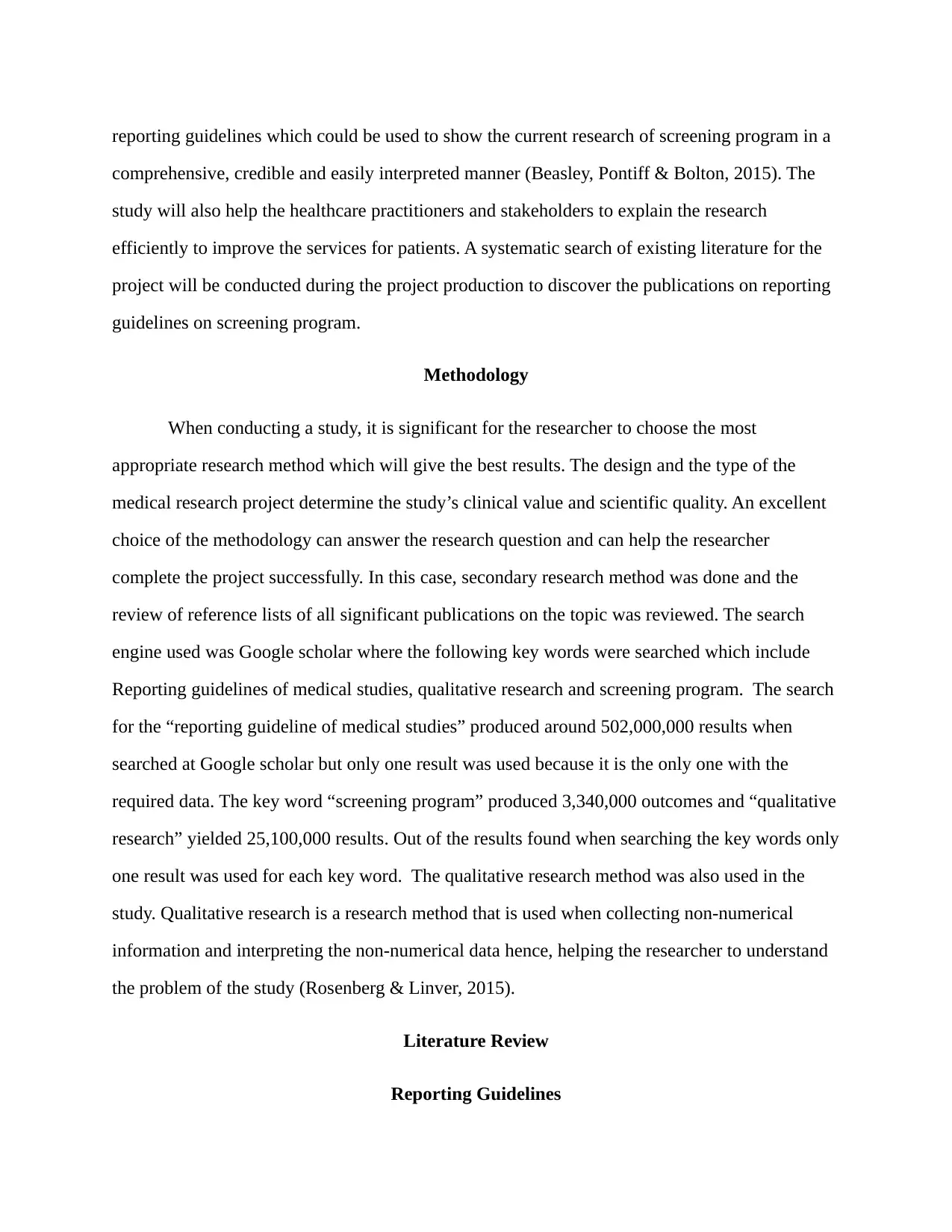
reporting guidelines which could be used to show the current research of screening program in a
comprehensive, credible and easily interpreted manner (Beasley, Pontiff & Bolton, 2015). The
study will also help the healthcare practitioners and stakeholders to explain the research
efficiently to improve the services for patients. A systematic search of existing literature for the
project will be conducted during the project production to discover the publications on reporting
guidelines on screening program.
Methodology
When conducting a study, it is significant for the researcher to choose the most
appropriate research method which will give the best results. The design and the type of the
medical research project determine the study’s clinical value and scientific quality. An excellent
choice of the methodology can answer the research question and can help the researcher
complete the project successfully. In this case, secondary research method was done and the
review of reference lists of all significant publications on the topic was reviewed. The search
engine used was Google scholar where the following key words were searched which include
Reporting guidelines of medical studies, qualitative research and screening program. The search
for the “reporting guideline of medical studies” produced around 502,000,000 results when
searched at Google scholar but only one result was used because it is the only one with the
required data. The key word “screening program” produced 3,340,000 outcomes and “qualitative
research” yielded 25,100,000 results. Out of the results found when searching the key words only
one result was used for each key word. The qualitative research method was also used in the
study. Qualitative research is a research method that is used when collecting non-numerical
information and interpreting the non-numerical data hence, helping the researcher to understand
the problem of the study (Rosenberg & Linver, 2015).
Literature Review
Reporting Guidelines
comprehensive, credible and easily interpreted manner (Beasley, Pontiff & Bolton, 2015). The
study will also help the healthcare practitioners and stakeholders to explain the research
efficiently to improve the services for patients. A systematic search of existing literature for the
project will be conducted during the project production to discover the publications on reporting
guidelines on screening program.
Methodology
When conducting a study, it is significant for the researcher to choose the most
appropriate research method which will give the best results. The design and the type of the
medical research project determine the study’s clinical value and scientific quality. An excellent
choice of the methodology can answer the research question and can help the researcher
complete the project successfully. In this case, secondary research method was done and the
review of reference lists of all significant publications on the topic was reviewed. The search
engine used was Google scholar where the following key words were searched which include
Reporting guidelines of medical studies, qualitative research and screening program. The search
for the “reporting guideline of medical studies” produced around 502,000,000 results when
searched at Google scholar but only one result was used because it is the only one with the
required data. The key word “screening program” produced 3,340,000 outcomes and “qualitative
research” yielded 25,100,000 results. Out of the results found when searching the key words only
one result was used for each key word. The qualitative research method was also used in the
study. Qualitative research is a research method that is used when collecting non-numerical
information and interpreting the non-numerical data hence, helping the researcher to understand
the problem of the study (Rosenberg & Linver, 2015).
Literature Review
Reporting Guidelines
⊘ This is a preview!⊘
Do you want full access?
Subscribe today to unlock all pages.

Trusted by 1+ million students worldwide
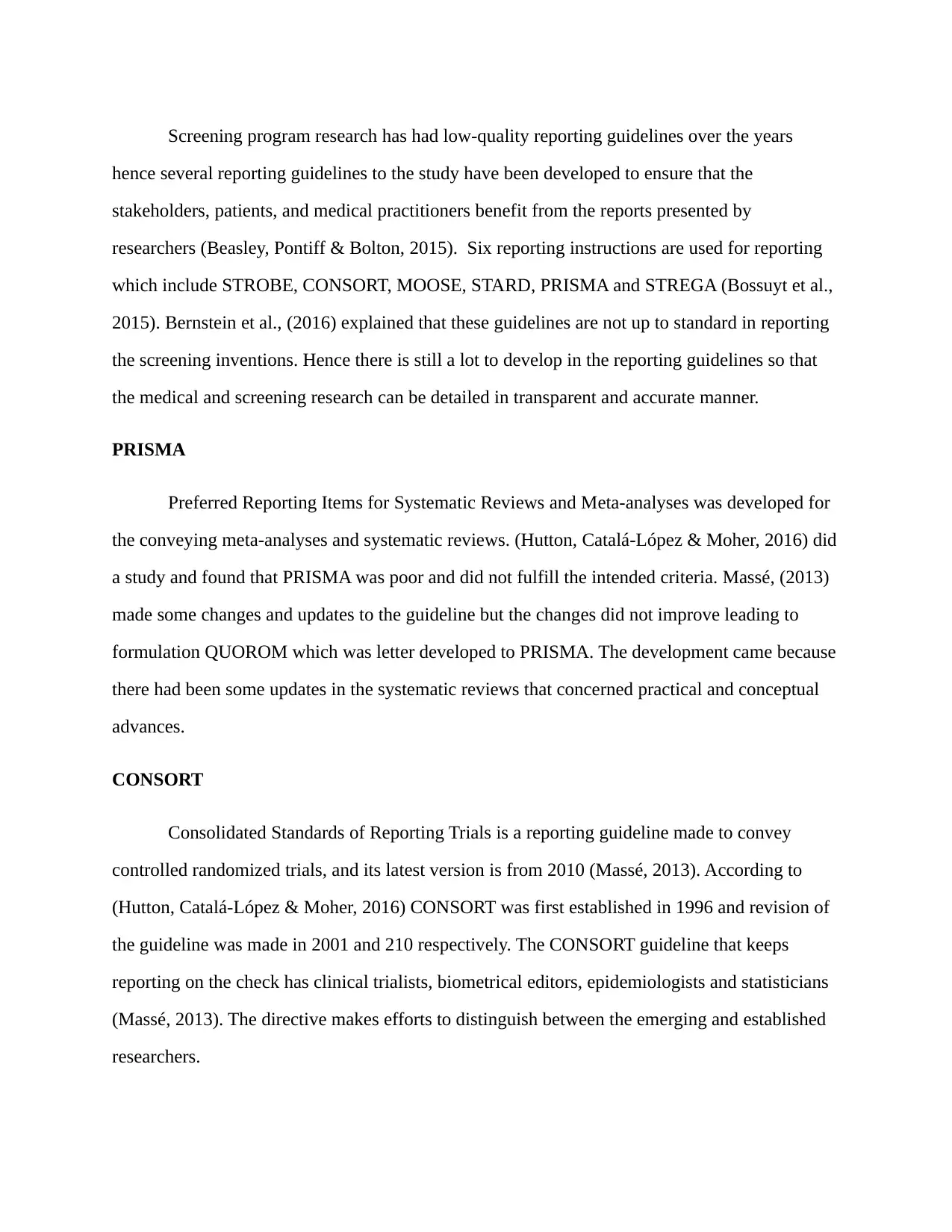
Screening program research has had low-quality reporting guidelines over the years
hence several reporting guidelines to the study have been developed to ensure that the
stakeholders, patients, and medical practitioners benefit from the reports presented by
researchers (Beasley, Pontiff & Bolton, 2015). Six reporting instructions are used for reporting
which include STROBE, CONSORT, MOOSE, STARD, PRISMA and STREGA (Bossuyt et al.,
2015). Bernstein et al., (2016) explained that these guidelines are not up to standard in reporting
the screening inventions. Hence there is still a lot to develop in the reporting guidelines so that
the medical and screening research can be detailed in transparent and accurate manner.
PRISMA
Preferred Reporting Items for Systematic Reviews and Meta-analyses was developed for
the conveying meta-analyses and systematic reviews. (Hutton, Catalá-López & Moher, 2016) did
a study and found that PRISMA was poor and did not fulfill the intended criteria. Massé, (2013)
made some changes and updates to the guideline but the changes did not improve leading to
formulation QUOROM which was letter developed to PRISMA. The development came because
there had been some updates in the systematic reviews that concerned practical and conceptual
advances.
CONSORT
Consolidated Standards of Reporting Trials is a reporting guideline made to convey
controlled randomized trials, and its latest version is from 2010 (Massé, 2013). According to
(Hutton, Catalá-López & Moher, 2016) CONSORT was first established in 1996 and revision of
the guideline was made in 2001 and 210 respectively. The CONSORT guideline that keeps
reporting on the check has clinical trialists, biometrical editors, epidemiologists and statisticians
(Massé, 2013). The directive makes efforts to distinguish between the emerging and established
researchers.
hence several reporting guidelines to the study have been developed to ensure that the
stakeholders, patients, and medical practitioners benefit from the reports presented by
researchers (Beasley, Pontiff & Bolton, 2015). Six reporting instructions are used for reporting
which include STROBE, CONSORT, MOOSE, STARD, PRISMA and STREGA (Bossuyt et al.,
2015). Bernstein et al., (2016) explained that these guidelines are not up to standard in reporting
the screening inventions. Hence there is still a lot to develop in the reporting guidelines so that
the medical and screening research can be detailed in transparent and accurate manner.
PRISMA
Preferred Reporting Items for Systematic Reviews and Meta-analyses was developed for
the conveying meta-analyses and systematic reviews. (Hutton, Catalá-López & Moher, 2016) did
a study and found that PRISMA was poor and did not fulfill the intended criteria. Massé, (2013)
made some changes and updates to the guideline but the changes did not improve leading to
formulation QUOROM which was letter developed to PRISMA. The development came because
there had been some updates in the systematic reviews that concerned practical and conceptual
advances.
CONSORT
Consolidated Standards of Reporting Trials is a reporting guideline made to convey
controlled randomized trials, and its latest version is from 2010 (Massé, 2013). According to
(Hutton, Catalá-López & Moher, 2016) CONSORT was first established in 1996 and revision of
the guideline was made in 2001 and 210 respectively. The CONSORT guideline that keeps
reporting on the check has clinical trialists, biometrical editors, epidemiologists and statisticians
(Massé, 2013). The directive makes efforts to distinguish between the emerging and established
researchers.
Paraphrase This Document
Need a fresh take? Get an instant paraphrase of this document with our AI Paraphraser
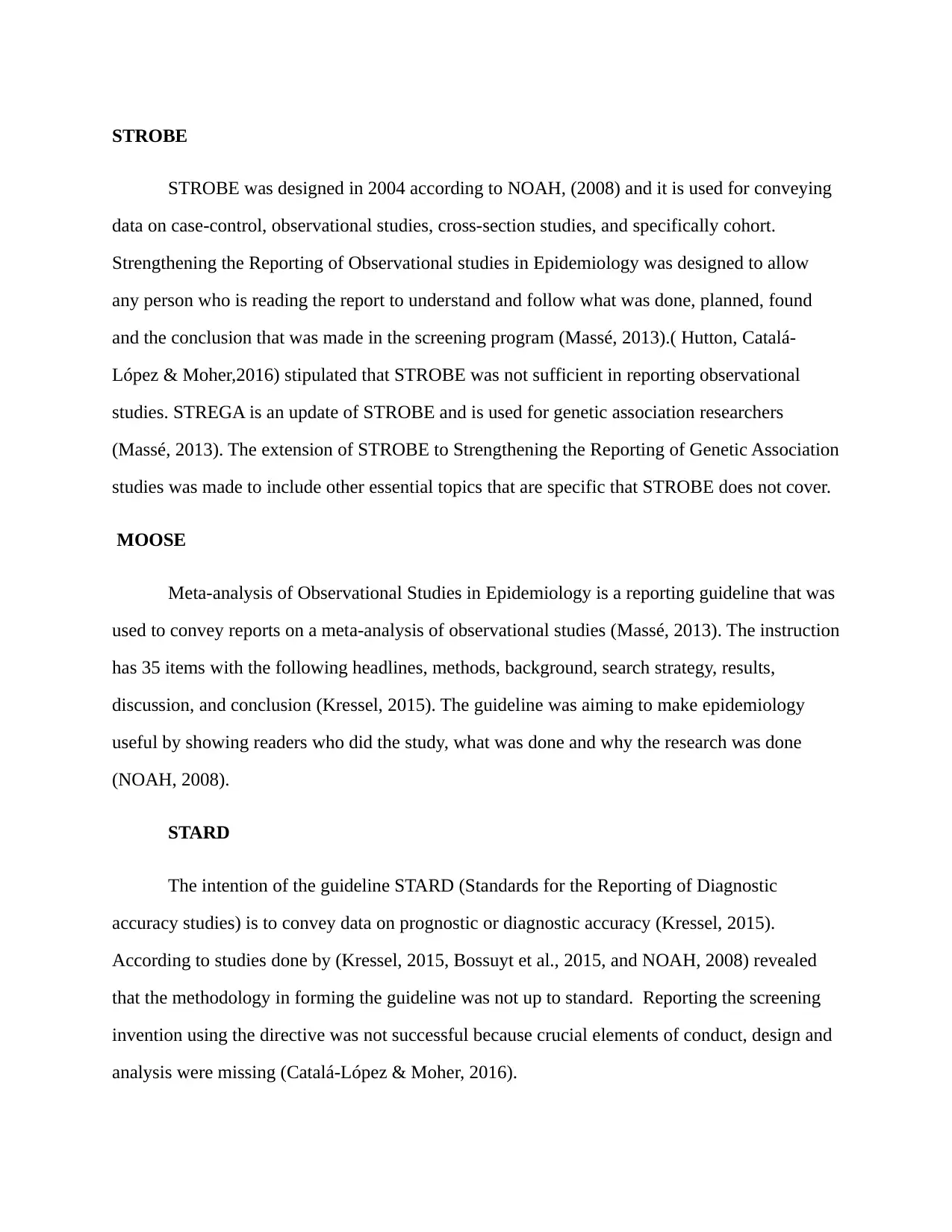
STROBE
STROBE was designed in 2004 according to NOAH, (2008) and it is used for conveying
data on case-control, observational studies, cross-section studies, and specifically cohort.
Strengthening the Reporting of Observational studies in Epidemiology was designed to allow
any person who is reading the report to understand and follow what was done, planned, found
and the conclusion that was made in the screening program (Massé, 2013).( Hutton, Catalá-
López & Moher,2016) stipulated that STROBE was not sufficient in reporting observational
studies. STREGA is an update of STROBE and is used for genetic association researchers
(Massé, 2013). The extension of STROBE to Strengthening the Reporting of Genetic Association
studies was made to include other essential topics that are specific that STROBE does not cover.
MOOSE
Meta-analysis of Observational Studies in Epidemiology is a reporting guideline that was
used to convey reports on a meta-analysis of observational studies (Massé, 2013). The instruction
has 35 items with the following headlines, methods, background, search strategy, results,
discussion, and conclusion (Kressel, 2015). The guideline was aiming to make epidemiology
useful by showing readers who did the study, what was done and why the research was done
(NOAH, 2008).
STARD
The intention of the guideline STARD (Standards for the Reporting of Diagnostic
accuracy studies) is to convey data on prognostic or diagnostic accuracy (Kressel, 2015).
According to studies done by (Kressel, 2015, Bossuyt et al., 2015, and NOAH, 2008) revealed
that the methodology in forming the guideline was not up to standard. Reporting the screening
invention using the directive was not successful because crucial elements of conduct, design and
analysis were missing (Catalá-López & Moher, 2016).
STROBE was designed in 2004 according to NOAH, (2008) and it is used for conveying
data on case-control, observational studies, cross-section studies, and specifically cohort.
Strengthening the Reporting of Observational studies in Epidemiology was designed to allow
any person who is reading the report to understand and follow what was done, planned, found
and the conclusion that was made in the screening program (Massé, 2013).( Hutton, Catalá-
López & Moher,2016) stipulated that STROBE was not sufficient in reporting observational
studies. STREGA is an update of STROBE and is used for genetic association researchers
(Massé, 2013). The extension of STROBE to Strengthening the Reporting of Genetic Association
studies was made to include other essential topics that are specific that STROBE does not cover.
MOOSE
Meta-analysis of Observational Studies in Epidemiology is a reporting guideline that was
used to convey reports on a meta-analysis of observational studies (Massé, 2013). The instruction
has 35 items with the following headlines, methods, background, search strategy, results,
discussion, and conclusion (Kressel, 2015). The guideline was aiming to make epidemiology
useful by showing readers who did the study, what was done and why the research was done
(NOAH, 2008).
STARD
The intention of the guideline STARD (Standards for the Reporting of Diagnostic
accuracy studies) is to convey data on prognostic or diagnostic accuracy (Kressel, 2015).
According to studies done by (Kressel, 2015, Bossuyt et al., 2015, and NOAH, 2008) revealed
that the methodology in forming the guideline was not up to standard. Reporting the screening
invention using the directive was not successful because crucial elements of conduct, design and
analysis were missing (Catalá-López & Moher, 2016).
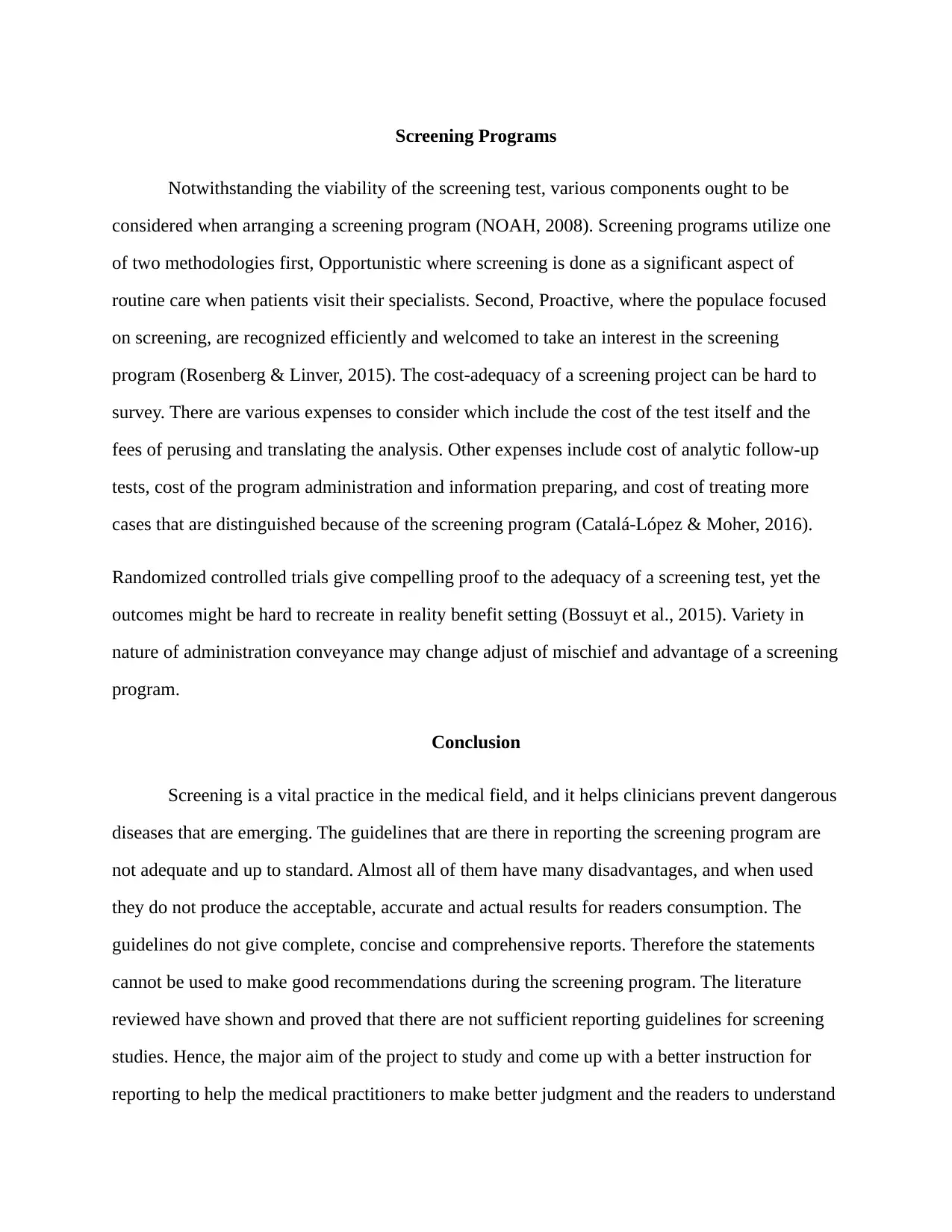
Screening Programs
Notwithstanding the viability of the screening test, various components ought to be
considered when arranging a screening program (NOAH, 2008). Screening programs utilize one
of two methodologies first, Opportunistic where screening is done as a significant aspect of
routine care when patients visit their specialists. Second, Proactive, where the populace focused
on screening, are recognized efficiently and welcomed to take an interest in the screening
program (Rosenberg & Linver, 2015). The cost-adequacy of a screening project can be hard to
survey. There are various expenses to consider which include the cost of the test itself and the
fees of perusing and translating the analysis. Other expenses include cost of analytic follow-up
tests, cost of the program administration and information preparing, and cost of treating more
cases that are distinguished because of the screening program (Catalá-López & Moher, 2016).
Randomized controlled trials give compelling proof to the adequacy of a screening test, yet the
outcomes might be hard to recreate in reality benefit setting (Bossuyt et al., 2015). Variety in
nature of administration conveyance may change adjust of mischief and advantage of a screening
program.
Conclusion
Screening is a vital practice in the medical field, and it helps clinicians prevent dangerous
diseases that are emerging. The guidelines that are there in reporting the screening program are
not adequate and up to standard. Almost all of them have many disadvantages, and when used
they do not produce the acceptable, accurate and actual results for readers consumption. The
guidelines do not give complete, concise and comprehensive reports. Therefore the statements
cannot be used to make good recommendations during the screening program. The literature
reviewed have shown and proved that there are not sufficient reporting guidelines for screening
studies. Hence, the major aim of the project to study and come up with a better instruction for
reporting to help the medical practitioners to make better judgment and the readers to understand
Notwithstanding the viability of the screening test, various components ought to be
considered when arranging a screening program (NOAH, 2008). Screening programs utilize one
of two methodologies first, Opportunistic where screening is done as a significant aspect of
routine care when patients visit their specialists. Second, Proactive, where the populace focused
on screening, are recognized efficiently and welcomed to take an interest in the screening
program (Rosenberg & Linver, 2015). The cost-adequacy of a screening project can be hard to
survey. There are various expenses to consider which include the cost of the test itself and the
fees of perusing and translating the analysis. Other expenses include cost of analytic follow-up
tests, cost of the program administration and information preparing, and cost of treating more
cases that are distinguished because of the screening program (Catalá-López & Moher, 2016).
Randomized controlled trials give compelling proof to the adequacy of a screening test, yet the
outcomes might be hard to recreate in reality benefit setting (Bossuyt et al., 2015). Variety in
nature of administration conveyance may change adjust of mischief and advantage of a screening
program.
Conclusion
Screening is a vital practice in the medical field, and it helps clinicians prevent dangerous
diseases that are emerging. The guidelines that are there in reporting the screening program are
not adequate and up to standard. Almost all of them have many disadvantages, and when used
they do not produce the acceptable, accurate and actual results for readers consumption. The
guidelines do not give complete, concise and comprehensive reports. Therefore the statements
cannot be used to make good recommendations during the screening program. The literature
reviewed have shown and proved that there are not sufficient reporting guidelines for screening
studies. Hence, the major aim of the project to study and come up with a better instruction for
reporting to help the medical practitioners to make better judgment and the readers to understand
⊘ This is a preview!⊘
Do you want full access?
Subscribe today to unlock all pages.

Trusted by 1+ million students worldwide
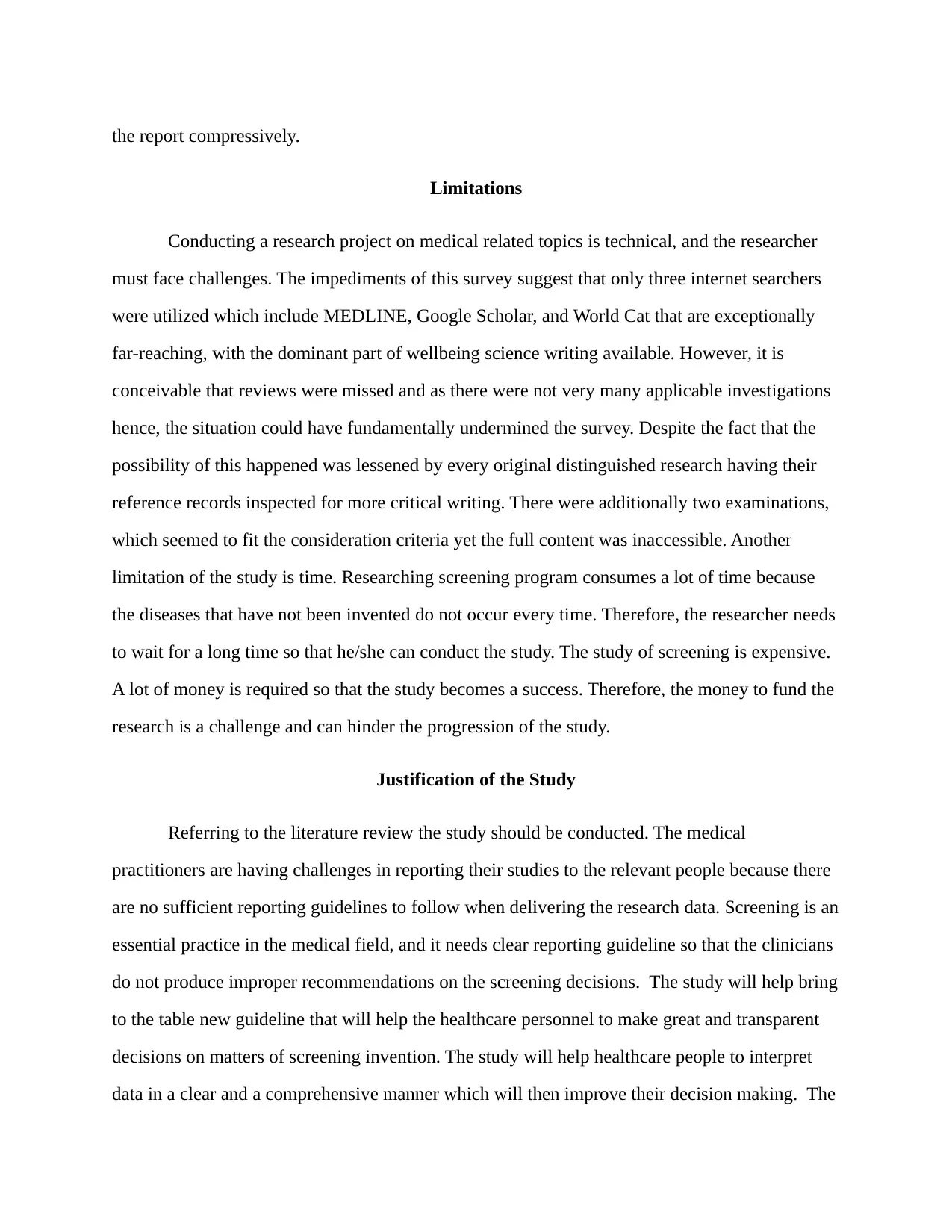
the report compressively.
Limitations
Conducting a research project on medical related topics is technical, and the researcher
must face challenges. The impediments of this survey suggest that only three internet searchers
were utilized which include MEDLINE, Google Scholar, and World Cat that are exceptionally
far-reaching, with the dominant part of wellbeing science writing available. However, it is
conceivable that reviews were missed and as there were not very many applicable investigations
hence, the situation could have fundamentally undermined the survey. Despite the fact that the
possibility of this happened was lessened by every original distinguished research having their
reference records inspected for more critical writing. There were additionally two examinations,
which seemed to fit the consideration criteria yet the full content was inaccessible. Another
limitation of the study is time. Researching screening program consumes a lot of time because
the diseases that have not been invented do not occur every time. Therefore, the researcher needs
to wait for a long time so that he/she can conduct the study. The study of screening is expensive.
A lot of money is required so that the study becomes a success. Therefore, the money to fund the
research is a challenge and can hinder the progression of the study.
Justification of the Study
Referring to the literature review the study should be conducted. The medical
practitioners are having challenges in reporting their studies to the relevant people because there
are no sufficient reporting guidelines to follow when delivering the research data. Screening is an
essential practice in the medical field, and it needs clear reporting guideline so that the clinicians
do not produce improper recommendations on the screening decisions. The study will help bring
to the table new guideline that will help the healthcare personnel to make great and transparent
decisions on matters of screening invention. The study will help healthcare people to interpret
data in a clear and a comprehensive manner which will then improve their decision making. The
Limitations
Conducting a research project on medical related topics is technical, and the researcher
must face challenges. The impediments of this survey suggest that only three internet searchers
were utilized which include MEDLINE, Google Scholar, and World Cat that are exceptionally
far-reaching, with the dominant part of wellbeing science writing available. However, it is
conceivable that reviews were missed and as there were not very many applicable investigations
hence, the situation could have fundamentally undermined the survey. Despite the fact that the
possibility of this happened was lessened by every original distinguished research having their
reference records inspected for more critical writing. There were additionally two examinations,
which seemed to fit the consideration criteria yet the full content was inaccessible. Another
limitation of the study is time. Researching screening program consumes a lot of time because
the diseases that have not been invented do not occur every time. Therefore, the researcher needs
to wait for a long time so that he/she can conduct the study. The study of screening is expensive.
A lot of money is required so that the study becomes a success. Therefore, the money to fund the
research is a challenge and can hinder the progression of the study.
Justification of the Study
Referring to the literature review the study should be conducted. The medical
practitioners are having challenges in reporting their studies to the relevant people because there
are no sufficient reporting guidelines to follow when delivering the research data. Screening is an
essential practice in the medical field, and it needs clear reporting guideline so that the clinicians
do not produce improper recommendations on the screening decisions. The study will help bring
to the table new guideline that will help the healthcare personnel to make great and transparent
decisions on matters of screening invention. The study will help healthcare people to interpret
data in a clear and a comprehensive manner which will then improve their decision making. The
Paraphrase This Document
Need a fresh take? Get an instant paraphrase of this document with our AI Paraphraser
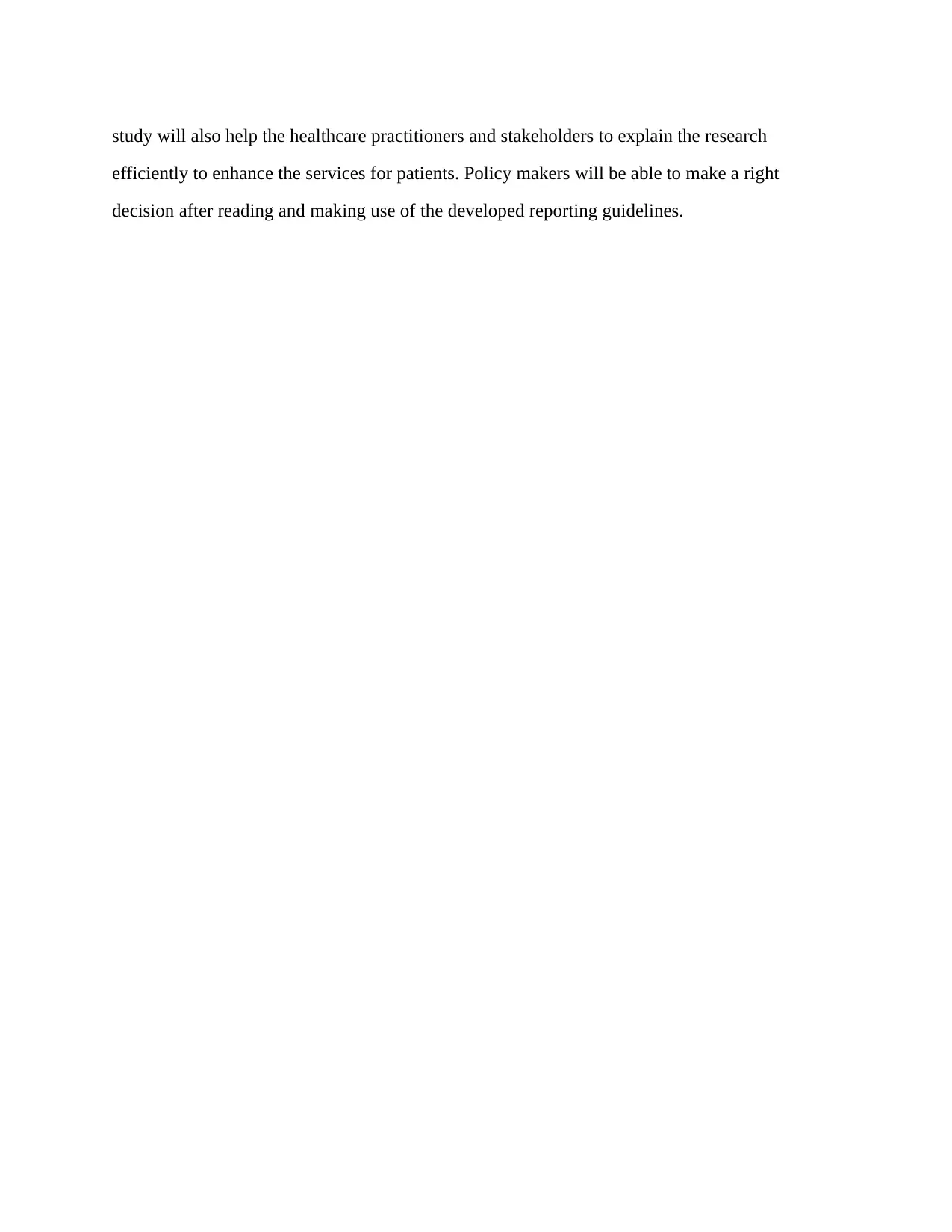
study will also help the healthcare practitioners and stakeholders to explain the research
efficiently to enhance the services for patients. Policy makers will be able to make a right
decision after reading and making use of the developed reporting guidelines.
efficiently to enhance the services for patients. Policy makers will be able to make a right
decision after reading and making use of the developed reporting guidelines.
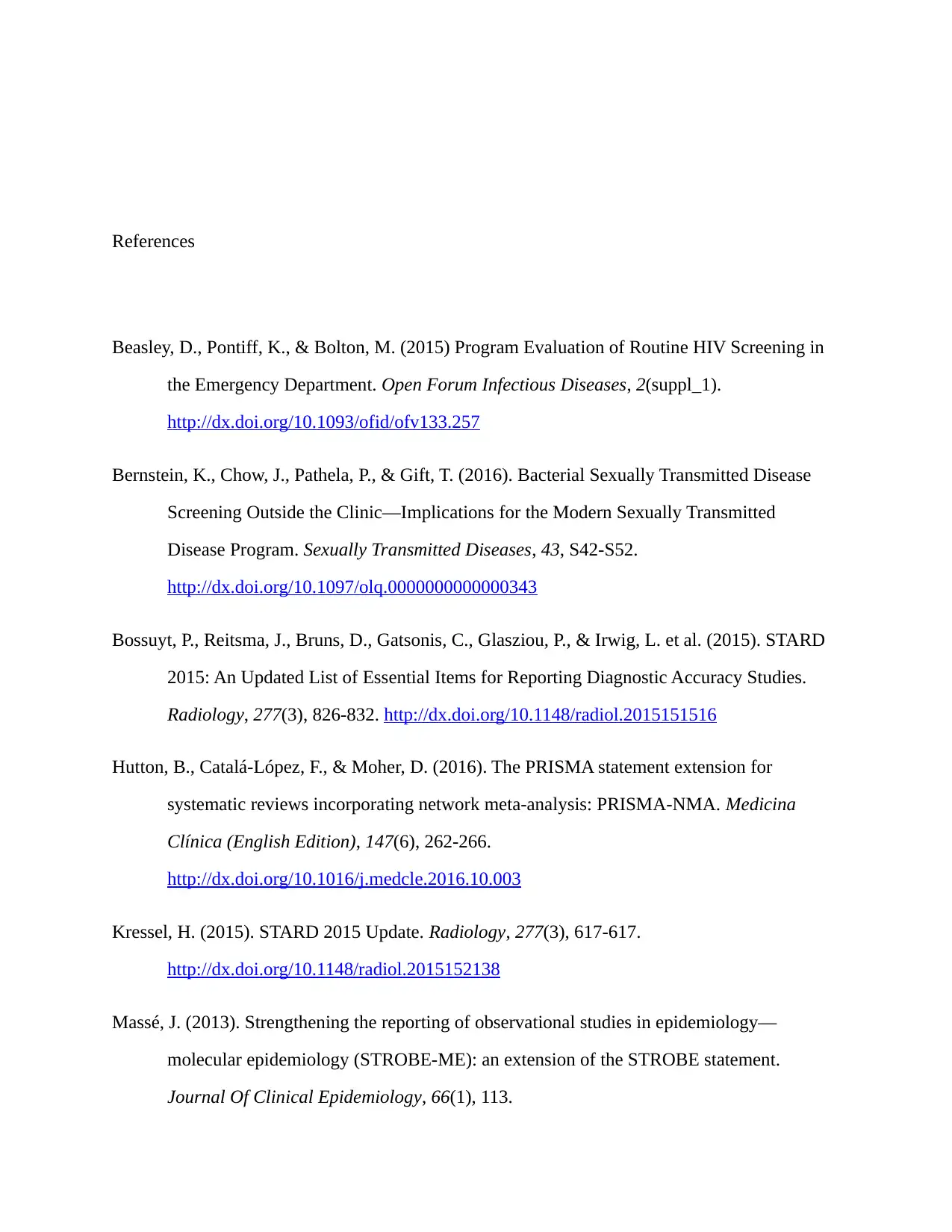
References
Beasley, D., Pontiff, K., & Bolton, M. (2015) Program Evaluation of Routine HIV Screening in
the Emergency Department. Open Forum Infectious Diseases, 2(suppl_1).
http://dx.doi.org/10.1093/ofid/ofv133.257
Bernstein, K., Chow, J., Pathela, P., & Gift, T. (2016). Bacterial Sexually Transmitted Disease
Screening Outside the Clinic—Implications for the Modern Sexually Transmitted
Disease Program. Sexually Transmitted Diseases, 43, S42-S52.
http://dx.doi.org/10.1097/olq.0000000000000343
Bossuyt, P., Reitsma, J., Bruns, D., Gatsonis, C., Glasziou, P., & Irwig, L. et al. (2015). STARD
2015: An Updated List of Essential Items for Reporting Diagnostic Accuracy Studies.
Radiology, 277(3), 826-832. http://dx.doi.org/10.1148/radiol.2015151516
Hutton, B., Catalá-López, F., & Moher, D. (2016). The PRISMA statement extension for
systematic reviews incorporating network meta-analysis: PRISMA-NMA. Medicina
Clínica (English Edition), 147(6), 262-266.
http://dx.doi.org/10.1016/j.medcle.2016.10.003
Kressel, H. (2015). STARD 2015 Update. Radiology, 277(3), 617-617.
http://dx.doi.org/10.1148/radiol.2015152138
Massé, J. (2013). Strengthening the reporting of observational studies in epidemiology—
molecular epidemiology (STROBE-ME): an extension of the STROBE statement.
Journal Of Clinical Epidemiology, 66(1), 113.
Beasley, D., Pontiff, K., & Bolton, M. (2015) Program Evaluation of Routine HIV Screening in
the Emergency Department. Open Forum Infectious Diseases, 2(suppl_1).
http://dx.doi.org/10.1093/ofid/ofv133.257
Bernstein, K., Chow, J., Pathela, P., & Gift, T. (2016). Bacterial Sexually Transmitted Disease
Screening Outside the Clinic—Implications for the Modern Sexually Transmitted
Disease Program. Sexually Transmitted Diseases, 43, S42-S52.
http://dx.doi.org/10.1097/olq.0000000000000343
Bossuyt, P., Reitsma, J., Bruns, D., Gatsonis, C., Glasziou, P., & Irwig, L. et al. (2015). STARD
2015: An Updated List of Essential Items for Reporting Diagnostic Accuracy Studies.
Radiology, 277(3), 826-832. http://dx.doi.org/10.1148/radiol.2015151516
Hutton, B., Catalá-López, F., & Moher, D. (2016). The PRISMA statement extension for
systematic reviews incorporating network meta-analysis: PRISMA-NMA. Medicina
Clínica (English Edition), 147(6), 262-266.
http://dx.doi.org/10.1016/j.medcle.2016.10.003
Kressel, H. (2015). STARD 2015 Update. Radiology, 277(3), 617-617.
http://dx.doi.org/10.1148/radiol.2015152138
Massé, J. (2013). Strengthening the reporting of observational studies in epidemiology—
molecular epidemiology (STROBE-ME): an extension of the STROBE statement.
Journal Of Clinical Epidemiology, 66(1), 113.
⊘ This is a preview!⊘
Do you want full access?
Subscribe today to unlock all pages.

Trusted by 1+ million students worldwide
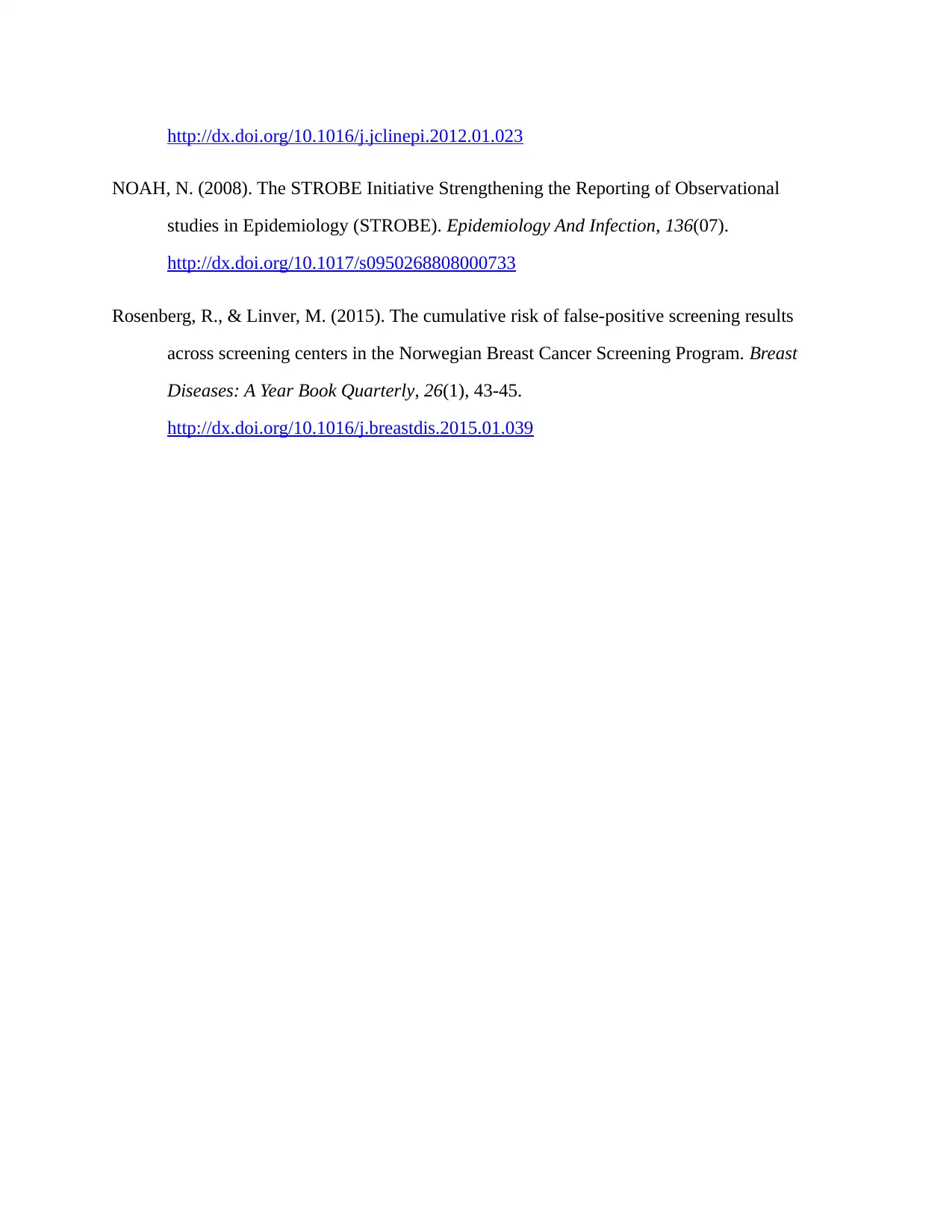
http://dx.doi.org/10.1016/j.jclinepi.2012.01.023
NOAH, N. (2008). The STROBE Initiative Strengthening the Reporting of Observational
studies in Epidemiology (STROBE). Epidemiology And Infection, 136(07).
http://dx.doi.org/10.1017/s0950268808000733
Rosenberg, R., & Linver, M. (2015). The cumulative risk of false-positive screening results
across screening centers in the Norwegian Breast Cancer Screening Program. Breast
Diseases: A Year Book Quarterly, 26(1), 43-45.
http://dx.doi.org/10.1016/j.breastdis.2015.01.039
NOAH, N. (2008). The STROBE Initiative Strengthening the Reporting of Observational
studies in Epidemiology (STROBE). Epidemiology And Infection, 136(07).
http://dx.doi.org/10.1017/s0950268808000733
Rosenberg, R., & Linver, M. (2015). The cumulative risk of false-positive screening results
across screening centers in the Norwegian Breast Cancer Screening Program. Breast
Diseases: A Year Book Quarterly, 26(1), 43-45.
http://dx.doi.org/10.1016/j.breastdis.2015.01.039
1 out of 10
Related Documents
Your All-in-One AI-Powered Toolkit for Academic Success.
+13062052269
info@desklib.com
Available 24*7 on WhatsApp / Email
![[object Object]](/_next/static/media/star-bottom.7253800d.svg)
Unlock your academic potential
Copyright © 2020–2025 A2Z Services. All Rights Reserved. Developed and managed by ZUCOL.





